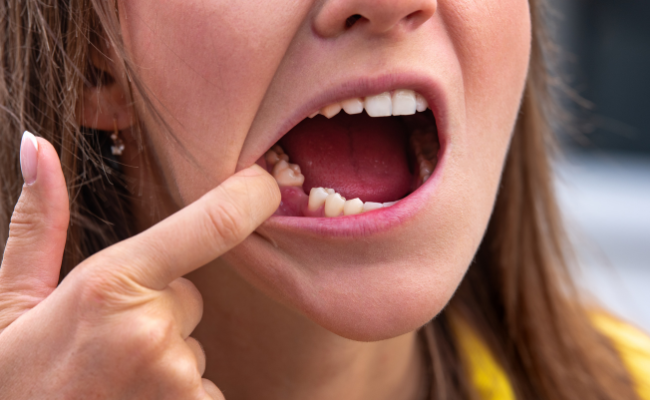How to Treat Knocked Out Tooth?
- January 10, 2024
- No Comments

What Happens When a Tooth Gets Knocked Out?
An avulsed tooth, also known as a knocked-out tooth, refers to a dental condition where a tooth is entirely dislodged from its socket. This occurrence, commonly associated with accidents or trauma, is considered a dental emergency. Immediate attention is crucial when dealing with an avulsed tooth to enhance the likelihood of successful re-implantation or other necessary dental interventions. Recognized colloquially as a "knocked-out tooth," this condition demands prompt and appropriate care to preserve the tooth and minimize potential complications.
Why Immediate Action Matters
Immediate action is crucial for several reasons. Firstly, the damaged blood vessels and nerves within the tooth can be protected from further harm if re-implantation is attempted promptly. Secondly, the longer the tooth remains outside the socket, the more challenging it becomes to re-establish blood flow and nerve function. Thirdly, the exposed root can quickly dry out, reducing the likelihood of successful re-implantation.
The success of re-implantation depends on the vitality of the tooth and the speed at which it is re-inserted. If treated promptly, there is a higher chance of the body accepting the tooth back into its natural position and allowing for the restoration of blood flow and nerve function.
How to Handle a Knocked-Out Tooth
- Pick it up by the Crown, Not the Root: The first step in handling a knocked-out tooth is to pick it up by the crown, the chewing surface. It's crucial to avoid touching the root to prevent damage to the delicate cells necessary for successful re-implantation. Using clean hands or a sterile cloth, gently pick up the tooth.
- Rinse, but Don't Scrub: If the tooth is dirty, it can be gently rinsed with milk or saline solution. It's important to avoid using water, soap, or any cleaning agents as these can cause further damage to the exposed root. The goal is to remove dirt without scrubbing or damaging the root surface.
- Attempt to Reinsert the Tooth: If possible, try to reinsert the tooth into the socket. Hold it in place by gently biting down on a clean piece of cloth or gauze. This helps keep the tooth in its natural environment, preventing it from drying out and increasing the chances of successful re-implantation.
- Keep it Moist: If reinsertion isn't possible, keeping the tooth moist is crucial. Place it in milk or the person's saliva. It's important to avoid storing the tooth in water as water can damage the sensitive cells on the root surface. The ideal solution is to keep it in the person's mouth, between the cheek and gum.
Treatment Solutions for a Knocked-Out Tooth
- Emergency Dental Care: Seeking immediate dental care after a tooth has been knocked out is paramount. Emergency dental services are equipped to handle such situations promptly. Call your dentist or visit the nearest emergency dental clinic.
- X-rays and Evaluation: A dentist will perform a thorough examination, including X-rays, to assess the extent of damage to the tooth and surrounding structures. This evaluation is crucial for determining the appropriate course of action. X-rays help identify fractures, dislocations, or any other complications that may affect the treatment plan.
- Re-Implantation: If the tooth is deemed viable, the dentist may attempt to re-implant it into the socket. This process involves carefully placing the tooth back in its original position and stabilizing it. The success of re-implantation depends on various factors, including the time elapsed since the injury and the condition of the tooth.
- Splinting: In some cases, the dentist may recommend splinting the knocked-out tooth to adjacent teeth for stabilization during the initial healing period. This helps prevent further damage and allows the tooth to reattach to the surrounding tissues. A splint is typically a flexible material that holds the tooth in place, providing support while healing occurs.
- Prescription Medications: To prevent infection, antibiotics may be prescribed, and pain medications may be recommended to manage discomfort during the recovery period. These medications contribute to a more comfortable and infection-free healing process.
Benefits of Prompt Treatment
- Increased Success Rate: Acting promptly significantly increases the chances of a successful outcome. The sooner the tooth is re-implanted or treated, the better the prognosis. Studies have shown that immediate care within the first 30 minutes to an hour offers the best chances of successful re-implantation.
- Preservation of Natural Tooth: Re-implanting the natural tooth is often the preferred option over replacement with dental prosthetics. Preserving the natural tooth maintains the aesthetic appearance and functionality of the smile. Dental prosthetics, while advanced, may not fully replicate the natural feel and function of a real tooth.
- Prevention of Complications: Timely treatment helps prevent complications such as infection, bone loss, and damage to surrounding teeth. Addressing the issue promptly minimizes the risk of long-term consequences, ensuring a healthier oral environment.
- Emotional Well-Being: Dental injuries, especially the loss of a tooth, can be emotionally distressing. Prompt treatment not only addresses the physical aspects but also provides emotional support to the individual, aiding in the overall recovery process. The psychological impact of losing a tooth can be significant, and timely intervention can help alleviate some of the distress associated with such an event.
Comments (0)